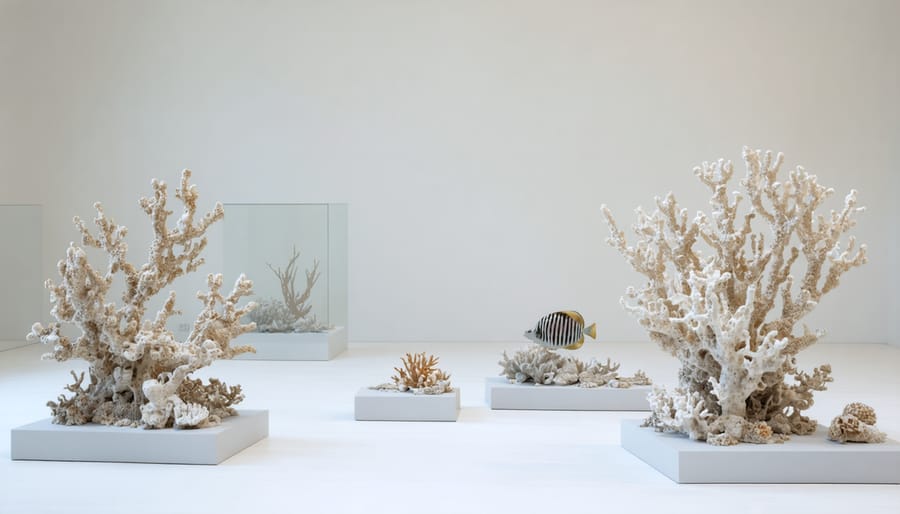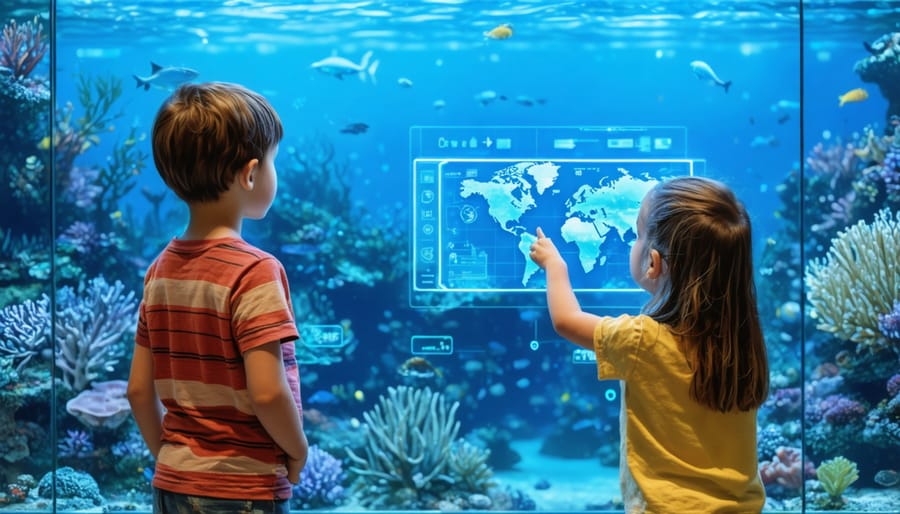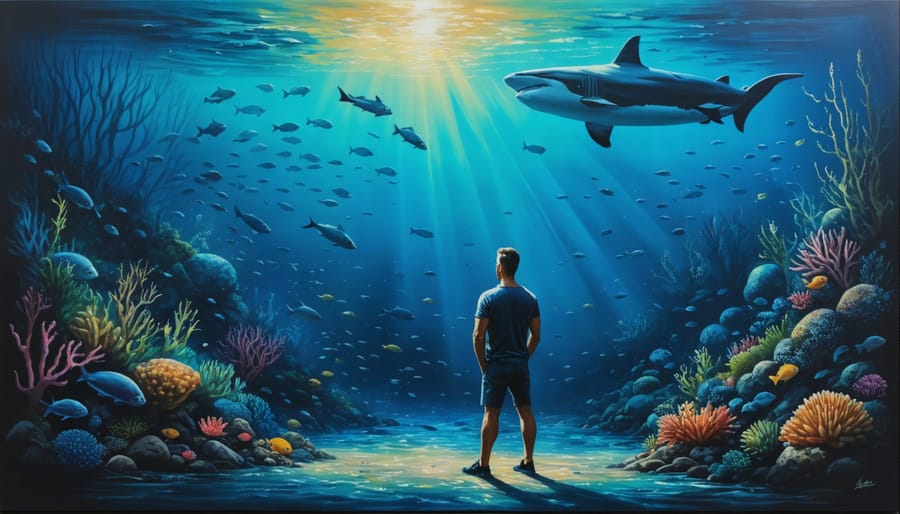
Standing as a testament to both military heritage and artistic expression, the National Museum of the Marine Corps in Quantico, Virginia, transforms marine science into art through its stunning 120,000-square-foot facility. This architectural marvel, crowned by a soaring 210-foot steel spire, welcomes visitors with its distinctive design inspired by the iconic image of Marines raising the flag at Iwo Jima. Inside, immersive galleries blend historical artifacts with cutting-edge interactive exhibits, creating a dynamic space where military history meets contemporary museum innovation. From the Leatherneck Gallery’s suspended aircraft to the Combat Art Gallery’s powerful wartime illustrations, the museum offers visitors an unparalleled journey through Marine Corps history while showcasing the intricate relationship between military service and artistic representation. Through state-of-the-art technology and thoughtfully curated exhibitions, this institution stands as a living memorial to the Corps’ enduring legacy and its influence on American culture and artistry.
Marine Life Through an Artistic Lens
Permanent Collections
The National Museum of the Marine Corps houses an extensive collection of marine-themed artwork that serves as a powerful testament to ocean conservation. The centerpiece of the permanent collection is the “Ocean’s Legacy” installation, featuring life-sized sculptures of endangered marine species crafted from reclaimed ocean plastics. This striking exhibit demonstrates the impact of human activity on marine ecosystems while showcasing the potential for transforming waste into art.
The “Maritime Memories” gallery displays a chronological timeline of marine biodiversity through oil paintings and photographs, documenting changes in ocean ecosystems over the past century. Each piece is accompanied by conservation data, helping visitors understand the urgent need for marine protection.
Interactive installations include the “Touch Tank Timeline,” where visitors can explore 3D-printed replicas of coral reef structures showing the effects of ocean acidification, and the “Marine Soundscape” room, featuring recordings of healthy versus degraded ocean environments. The museum’s commitment to conservation education is further emphasized through its rotating collection of student artwork, created during educational workshops focused on marine preservation and sustainability.

Rotating Exhibitions
The National Museum of the Marine Corps features dynamic rotating exhibitions that blend marine science with artistic expression. Current highlights include “Ocean’s Pulse,” a multimedia installation showcasing bioluminescent creatures through interactive light displays and original photography. This exhibit partners with leading marine biologists to educate visitors about deep-sea ecosystems and their conservation challenges.
Another compelling exhibition, “Tides of Change,” presents works from international artists addressing marine pollution through sculpture, photography, and digital media. Created from recovered ocean plastics and ghost nets, these pieces powerfully illustrate human impact on marine environments while suggesting paths toward restoration.
The museum’s partnership with local environmental organizations enriches these exhibitions through guided tours and hands-on workshops. Visitors can participate in conservation-themed art activities, learning about marine species while creating their own ocean-inspired artwork. A highlight is the “Young Marine Artists” program, where students collaborate with marine scientists to develop exhibitions that communicate urgent environmental messages through creative expression.
Future exhibitions will explore coral reef ecosystems, sustainable fishing practices, and climate change impacts on marine biodiversity, maintaining the museum’s commitment to environmental education through artistic engagement.
Interactive Marine Conservation Displays
Educational Installations
The museum’s educational installations bring marine biodiversity to life through cutting-edge interactive displays that seamlessly blend technology with artistic marine education. Visitors can explore touch-screen exhibits showcasing different marine ecosystems, from coastal wetlands to deep-sea environments, each featuring detailed information about native species and their ecological roles.
A highlight of the installation is the “Marine Life Discovery Zone,” where visitors can manipulate 3D holographic projections of various marine species, examining their anatomical features and behaviors in stunning detail. The “Ocean Current Simulator” demonstrates how marine creatures navigate global water movements, while the “Coral Reef Observatory” offers real-time footage from partner research stations worldwide.
Interactive learning stations encourage hands-on exploration, featuring preserved specimens, marine animal skulls, and replica artifacts that visitors can handle while learning about marine conservation. Children particularly enjoy the “Junior Marine Biologist” station, where they can conduct simple experiments and learn about scientific methodology through age-appropriate activities.
Digital kiosks throughout the installation provide up-to-date information about ongoing marine research projects and conservation efforts, connecting visitors with opportunities to contribute to marine preservation initiatives in their local communities.
Conservation Technology
The museum’s conservation technology exhibits blend cutting-edge multimedia displays with interactive learning experiences, showcasing the latest innovations in marine protection. Visitors can explore 3D holographic representations of endangered marine species and their habitats, offering an immersive understanding of ocean ecosystems. A state-of-the-art touch-screen wall allows guests to track real-time marine conservation efforts worldwide, from coral reef restoration projects to sea turtle protection initiatives.
The centerpiece of this section features a virtual reality experience where visitors can “dive” into different marine environments and witness firsthand the impacts of conservation efforts. Interactive displays demonstrate how advanced tracking systems, satellite monitoring, and underwater drones are revolutionizing marine research and protection strategies.
Digital kiosks throughout the exhibit highlight success stories from marine biologists and conservationists working in the field. These personal narratives are complemented by real-time data visualizations showing the positive impacts of various conservation technologies. A dedicated learning station allows visitors to experiment with marine monitoring equipment and understand how scientists collect crucial environmental data.
The exhibit concludes with an interactive pledge station where visitors can learn about volunteer opportunities and ways to support marine conservation efforts in their communities.

Artist-Scientist Collaborations
The National Museum of the Marine Corps has pioneered innovative collaborations between marine scientists and artists, creating powerful exhibits that blend scientific accuracy with artistic expression. These partnerships have resulted in stunning installations that educate visitors about marine ecosystems while capturing their imagination through various artistic mediums.
One notable project features underwater photographer Sarah Martinez working alongside marine biologist Dr. James Chen to document the effects of climate change on coral reefs. Their collaborative exhibition combines high-resolution photography with detailed scientific data, presenting visitors with both visual and empirical evidence of changing marine environments.
The museum’s “Ocean Artistry” program pairs local artists with research teams during marine expeditions. Artists spend weeks at sea, creating works inspired by scientific discoveries and marine life observations. This unique approach has produced remarkable pieces, including large-scale sculptures made from recovered ocean plastics and detailed scientific illustrations of newly discovered species.
Digital artists have also joined forces with oceanographers to create interactive installations that simulate deep-sea environments. Using data from research vessels and underwater monitoring stations, these exhibits allow visitors to experience the depths of the ocean through immersive virtual reality experiences.
The museum’s annual “Science Meets Art” symposium brings together marine researchers, environmental artists, and conservation specialists to develop new ways of communicating complex marine science concepts to the public. These collaborations have led to innovative educational programs that combine hands-on scientific activities with artistic expression.
Recent projects include a series of murals depicting marine ecosystems, painted using scientifically accurate colors derived from spectral analysis of underwater photographs. These works serve both as striking artistic pieces and as teaching tools for marine biology classes visiting the museum.
Through these collaborations, the museum continues to demonstrate how art can make marine science more accessible and engaging for visitors of all ages, while maintaining scientific integrity and educational value.

Community Engagement Programs
Workshop Series
The museum’s workshop series offers hands-on experiences that blend marine science with artistic expression. Monthly sessions include watercolor painting of marine life, sculpting with recycled ocean materials, and nature journaling focused on local aquatic ecosystems. Led by professional marine artists and environmental educators, these workshops cater to both beginners and experienced artists.
Popular offerings include “Marine Life Sketching,” where participants learn anatomical drawing techniques while studying preserved specimens, and “Ocean Conservation Through Art,” which teaches participants to create compelling visual narratives about marine protection. The “Youth Marine Artists” program, designed for ages 8-16, introduces young minds to marine biology through creative projects.
Each workshop emphasizes the importance of marine conservation, with instructors sharing insights about the species and habitats that inspire the artwork. Participants often contribute their creations to the museum’s rotating community art gallery, creating a collaborative space where art and science intersect.
Conservation Events
The museum hosts dynamic events throughout the year that blend artistic expression with marine conservation education. The signature “Ocean Arts Festival” occurs every spring, featuring local artists creating marine-themed sculptures from recycled beach debris while marine biologists provide interactive demonstrations about ocean pollution. Monthly “Science through Art” workshops invite children and adults to explore marine ecosystems through hands-on activities, including coral reef painting sessions and marine life sketching classes.
The museum’s innovative performance-based marine conservation events, such as the “Dancing with Dolphins” program, combine interpretive dance with educational narratives about marine mammals. These events typically conclude with volunteer sign-up opportunities for local beach cleanups and citizen science projects. Special exhibitions frequently partner with environmental organizations to showcase photography collections documenting marine habitat restoration efforts and success stories in species conservation.
The National Museum of the Marine Corps has evolved beyond its role as a historical institution to become a powerful advocate for marine conservation through artistic expression. By seamlessly blending scientific education with compelling visual narratives, the museum creates an emotional connection between visitors and our oceans’ fragile ecosystems. The museum’s rotating exhibitions of marine-themed artwork, from underwater photography to sculptures crafted from reclaimed ocean plastics, serve as stark reminders of both the ocean’s beauty and its vulnerability.
Through collaborative projects with marine biologists and environmental artists, the museum has created immersive experiences that translate complex conservation challenges into accessible visual stories. These artistic interpretations help visitors understand critical issues like coral reef degradation, marine pollution, and species extinction in ways that raw data alone cannot achieve.
The museum’s commitment to conservation education through art has inspired countless visitors to become ocean advocates themselves. Many leave with not just a deeper appreciation for marine life but also practical knowledge about how they can contribute to conservation efforts. This unique approach to environmental education demonstrates how cultural institutions can serve as bridges between scientific understanding and public action, making marine conservation accessible and meaningful to everyone who walks through its doors.
jessica
Ava Singh is an environmental writer and marine sustainability advocate with a deep commitment to protecting the world's oceans and coastal communities. With a background in environmental policy and a passion for storytelling, Ava brings complex topics to life through clear, engaging content that educates and empowers readers. At the Marine Biodiversity & Sustainability Learning Center, Ava focuses on sharing impactful stories about community engagement, policy innovations, and conservation strategies. Her writing bridges the gap between science and the public, encouraging people to take part in preserving marine biodiversity. When she’s not writing, Ava collaborates with local initiatives to promote eco-conscious living and sustainable development, ensuring her work makes a difference both on the page and in the real world.
